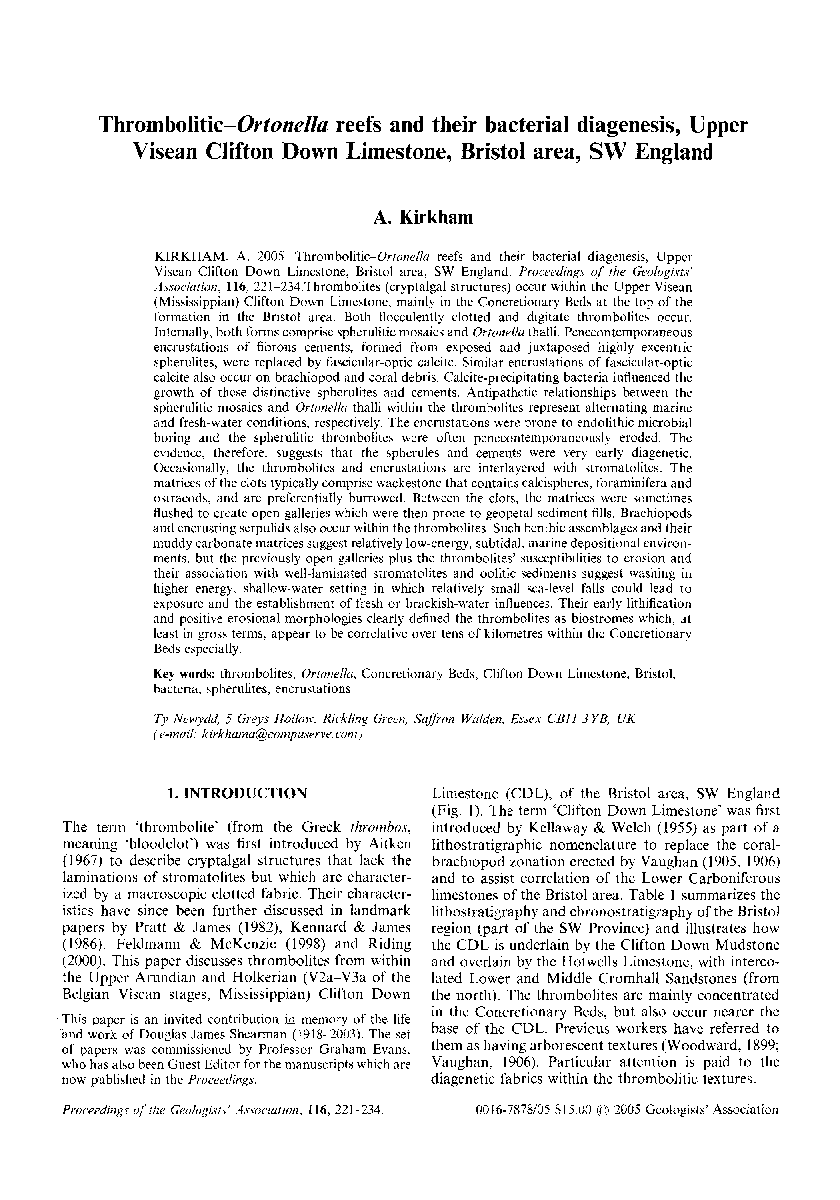| کد مقاله | کد نشریه | سال انتشار | مقاله انگلیسی | نسخه تمام متن |
|---|---|---|---|---|
| 10120773 | 1640689 | 2005 | 14 صفحه PDF | دانلود رایگان |
عنوان انگلیسی مقاله ISI
Thrombolitic-Ortonella reefs and their bacterial diagenesis, Upper Visean Clifton Down Limestone, Bristol area, SW England
دانلود مقاله + سفارش ترجمه
دانلود مقاله ISI انگلیسی
رایگان برای ایرانیان
کلمات کلیدی
موضوعات مرتبط
مهندسی و علوم پایه
علوم زمین و سیارات
زمین شناسی
پیش نمایش صفحه اول مقاله

چکیده انگلیسی
Thrombolites (cryptalgal structures) occur within the Upper Visean (Mississippian) Clifton Down Limestone, mainly in the Concretionary Beds at the top of the formation in the Bristol area. Both flocculently clotted and digitate thrombolites occur. Internally, both forms comprise spherulitic mosaics and Ortonella thalli. Penecontemporaneous encrustations of fibrous cements, formed from exposed and juxtaposed highly excentric spherulites, were replaced by fascicular-optic calcite. Similar encrustations of fascicular-optic calcite also occur on brachiopod and coral debris. Calcite-precipitating bacteria influenced the growth of these distinctive spherulites and cements. Antipathetic relationships between the spherulitic mosaics and Ortonella thalli within the thrombolites represent alternating marine and fresh-water conditions, respectively. The encrustations were prone to endolithic microbial boring and the spherulitic thrombolites were often penecontemporaneously eroded. The evidence, therefore, suggests that the spherules and cements were very early diagenetic. Occasionally, the thrombolites and encrustations are interlayered with stromatolites. The matrices of the clots typically comprise wackestone that contains calcispheres, foraminifera and ostracods, and are preferentially burrowed. Between the clots, the matrices were sometimes flushed to create open galleries which were then prone to geopetal sediment fills. Brachiopods and encrusting serpulids also occur within the thrombolites. Such benthic assemblages and their muddy carbonate matrices suggest relatively low-energy, subtidal, marine depositional environments, but the previously open galleries plus the thrombolites' susceptibilities to erosion and their association with well-laminated stromatolites and oolitic sediments suggest washing in higher energy, shallow-water setting in which relatively small sea-level falls could lead to exposure and the establishment of fresh or brackish-water influences. Their early lithification and positive erosional morphologies clearly defined the thrombolites as biostromes which, at least in gross terms, appear to be correlative over tens of kilometres within the Concretionary Beds especially.
ناشر
Database: Elsevier - ScienceDirect (ساینس دایرکت)
Journal: Proceedings of the Geologists' Association - Volume 116, Issues 3â4, 2005, Pages 221-234
Journal: Proceedings of the Geologists' Association - Volume 116, Issues 3â4, 2005, Pages 221-234
نویسندگان
A. Kirkham,